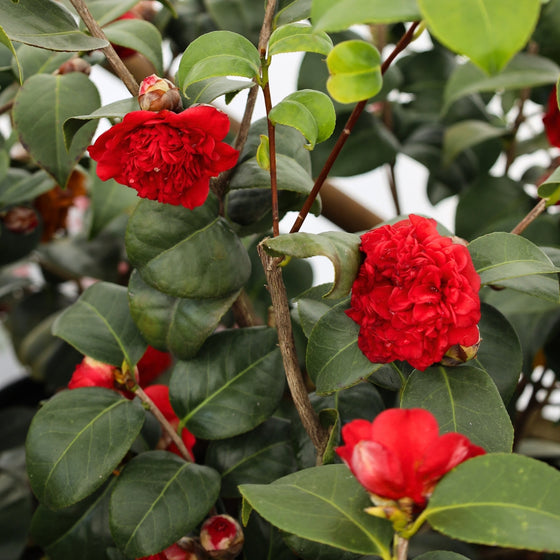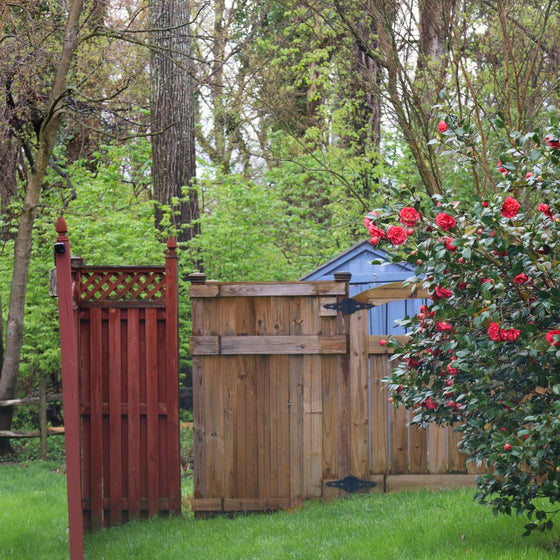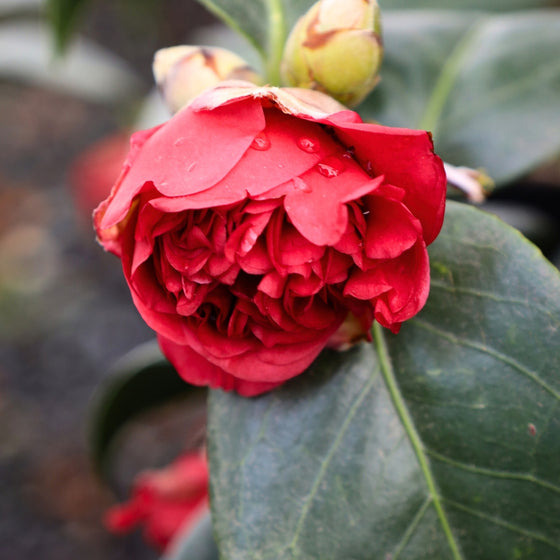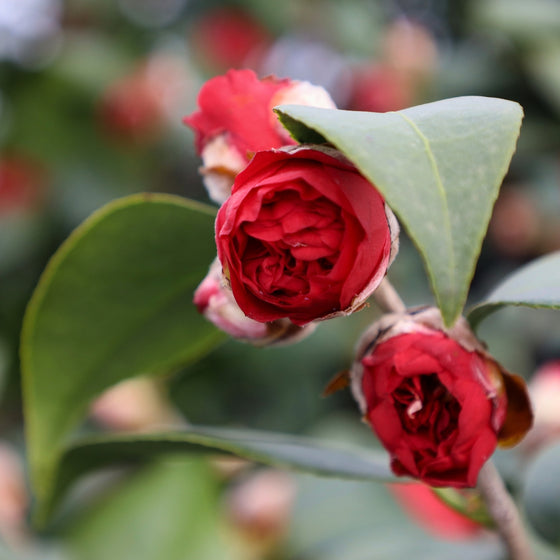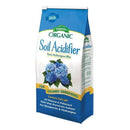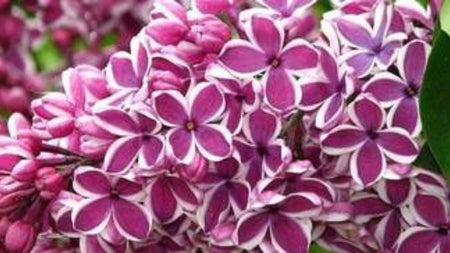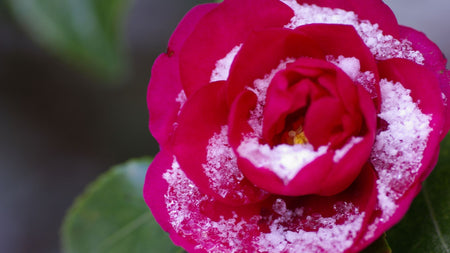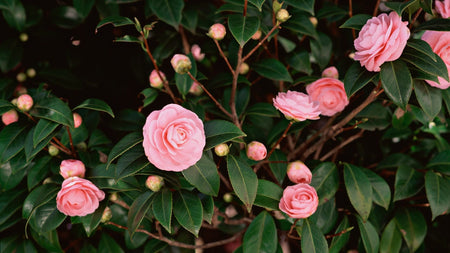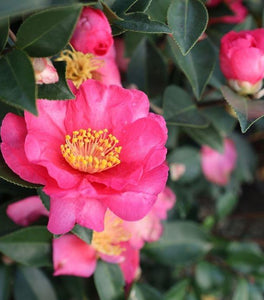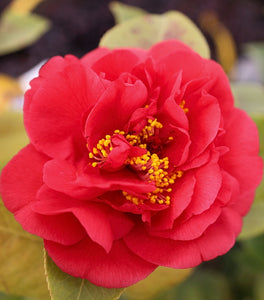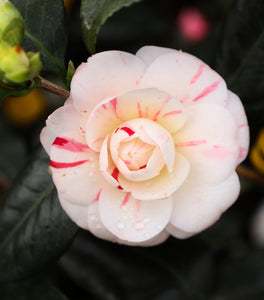
Images Depict Mature Plants
Camellia Professor Sargent Shrubs for Sale Online
Professor Sargent Camellia is a magnificent evergreen shrub renowned for its striking, large red blooms that add dramatic flair to any garden. The flowers, characterized by their formal double form and rich crimson color, appear from late winter to early spring, providing an eye-catching display when most other plants are still dormant. The dense, glossy, dark green foliage offers a beautiful contrast to the brilliant red blooms, making Professor Sargent Camellia an ideal focal point in any landscape. With a mature height of 6 to 10 feet and a spread of 6 to 8 feet, this shrub is perfect for use as a specimen plant, a flowering hedge, or a stunning addition to mixed borders.
Professor Sargent Camellia thrives in partial shade, ideally with morning sun and afternoon shade, which helps protect its vibrant red blooms from the harsh midday heat. This camellia prefers well-drained, slightly acidic soil, and benefits from the addition of organic matter, such as compost or peat moss, to maintain optimal growth. Its moderate growth rate makes it easy to manage, allowing it to develop into a lush, well-shaped shrub with minimal pruning requirements. Professor Sargent is also resistant to deer, making it a reliable option for gardens in areas where deer are known to browse. Whether used as a hedge, a foundation planting, or a standalone statement piece, this camellia adds year-round elegance and structure to your landscape.
This camellia variety is also well-suited for growing in large containers, allowing you to bring its vibrant blooms and glossy foliage to patios, decks, or entryways. Professor Sargent Camellia makes a spectacular statement when planted in pots, especially during its blooming season, providing brilliant color and texture to your outdoor living areas. Proper care, including regular watering, mulching, and annual fertilizing with an acidic, slow-release fertilizer, will keep this camellia healthy and thriving. With its bold red blooms, evergreen foliage, and relatively low maintenance requirements, Professor Sargent Camellia is a standout addition that brings lasting beauty and timeless charm to any garden setting.
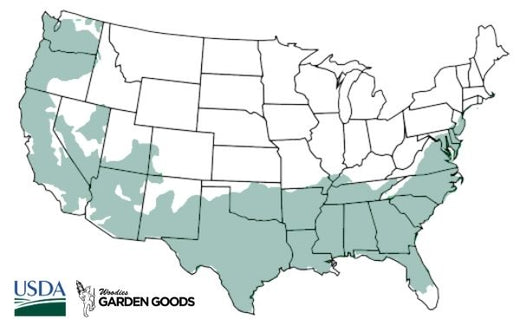
| Hardiness Zone: | 7-9 |
|---|---|
| Mature Height: | 8 to 10 feet |
| Mature Width: | 6 to 8 feet |
| Classification: | Broad Leaved evergreen shrub, Spring flowering |
| Sunlight: | Full Sun to Part Shade |
| Habit: | Evergreen, densely branched |
| Flower Color: | Dark Red Flowers in very early spring |
| Foliage: | Dark green |
| Soil Condition: | Any well drained soil |
| Water Requirements: | Water well until established |
| Uses: | Extremely attractive when used as a focal point in the mixed border, mass planting, or a specimen planting. Provides unmatched winter interest due to its flowering in the late winter |
How to Care for Professor Sargent Camellia
Be sure to read our planting instructions to ensure a healthy and happy Professor Sargent Camellia for years to come!
How Do I Plant A Professor Sargent Camellia?
To plant a Professor Sargent Camellia, begin by choosing a location that offers partial shade, preferably with morning sun and afternoon shade, to protect the delicate blooms from harsh sunlight. Professor Sargent Camellia thrives in well-drained, slightly acidic soil, so it's essential to prepare the planting site by incorporating organic matter like compost or peat moss to enrich the soil and improve drainage. Start by digging a hole that is twice as wide as the root ball and as deep as the root ball itself, allowing the roots enough space to spread comfortably. Position the camellia in the hole so that the top of the root ball is level with or slightly above the ground, as planting too deeply can lead to root rot. Once placed, backfill the hole with soil, gently firming it around the roots, and water thoroughly to settle the plant in and eliminate any air pockets. After planting your Professor Sargent Camellia, apply a 2-3 inch layer of organic mulch around the base to help retain moisture, regulate soil temperature, and suppress weeds. Be careful to keep the mulch a few inches away from the trunk to avoid moisture-related rot. During the first growing season, keep the soil consistently moist but not soggy by watering regularly, especially during dry spells, to support root establishment. If you are planting multiple camellias to form a hedge or screen, space them 5 to 6 feet apart to allow ample room for growth while still creating a dense, overlapping barrier. With proper planting and care, Professor Sargent Camellia will thrive in your garden, rewarding you with its stunning red blooms and glossy evergreen foliage that provide a vibrant burst of color and texture.
How Do I Water A Professor Sargent Camellia?
To water a Professor Sargent Camellia, it's crucial to maintain consistent soil moisture, especially during the first year after planting when the shrub is establishing its roots. Water deeply once or twice a week, depending on weather conditions, ensuring the root zone is thoroughly hydrated. A slow, deep watering method, such as using a soaker hose, is ideal for allowing water to penetrate the soil effectively, promoting deep root growth. During hot or dry periods, you may need to increase the frequency of watering to prevent the soil from drying out completely, as Professor Sargent Camellia prefers moist but well-drained soil. Avoid shallow watering, as it can lead to weak root development, and always ensure the soil drains well to prevent root rot. Once Professor Sargent Camellia is well-established, it becomes more tolerant of occasional dry spells, but regular watering is still important, especially during extended periods of heat or drought. To help maintain soil moisture, apply a 2-3 inch layer of organic mulch around the base of the shrub. Mulching not only helps retain moisture but also keeps the roots cool during the summer and prevents weed growth, which competes for water and nutrients. Be sure to keep the mulch a few inches away from the trunk to prevent rot. By providing consistent, deep watering, your Professor Sargent Camellia will thrive, producing lush evergreen foliage and an abundance of vibrant red blooms that brighten your garden during late winter and early spring.
How Do I Fertilizer A Professor Sargent Camellia?
To fertilize a Professor Sargent Camellia, begin in early spring before new growth appears to provide the necessary nutrients for healthy foliage and abundant blooms. Use an acidic, slow-release fertilizer formulated for camellias, azaleas, or rhododendrons, as these plants thrive in slightly acidic soil. A balanced fertilizer, such as 10-10-10, will help support vibrant growth and the production of large, double red flowers. Apply the fertilizer evenly around the base of the plant, extending out to the drip line to ensure that the nutrients reach the active root zone. Avoid placing the fertilizer too close to the trunk, as this can lead to root burn. After applying the fertilizer, water thoroughly to help it dissolve and penetrate the soil effectively. In addition to chemical fertilizers, consider adding organic matter such as compost or well-rotted manure around the base of your Professor Sargent Camellia in early spring. This will improve soil structure, support healthy microbial activity, and provide a slow-release source of nutrients throughout the growing season. Maintaining the soil's pH between 5.5 and 6.5 is crucial for nutrient uptake, so you may need to adjust the pH using sulfur if necessary. It's important not to over-fertilize, as too much nitrogen can lead to excessive leaf growth at the expense of blooms. With proper fertilization, your Professor Sargent Camellia will flourish, showcasing glossy evergreen foliage and a profusion of striking red blooms each year.

How Do I Prune A Professor Sargent Camellia?
To prune a Professor Sargent Camellia, the ideal time is in late spring, immediately after the blooming period ends. This ensures that you won’t accidentally remove the developing buds for next year's blooms, allowing the shrub to produce a full and vibrant display. Start by removing any dead, damaged, or diseased branches to keep the plant healthy and prevent the spread of disease. It’s also important to thin out crowded areas by pruning some of the interior branches, which will improve airflow and light penetration within the shrub, reducing the risk of fungal problems and promoting vigorous growth. Use clean, sharp pruning shears to make precise cuts, which helps reduce plant stress and promotes quicker healing. When shaping Professor Sargent Camellia, focus on selective pruning rather than heavy shearing to maintain its natural, open form and encourage healthy new growth. Cut back the longest branches to keep the shrub compact and well-balanced, but avoid cutting too much at once, as excessive pruning can reduce flowering. For those using Professor Sargent Camellia as a hedge, light pruning throughout the growing season can help maintain the desired shape and size without sacrificing the beautiful blooms. Proper pruning will enhance the structure of the shrub, keep it manageable, and ensure that it produces its signature bright red double flowers, creating a stunning display of color and texture in your garden year after year.

